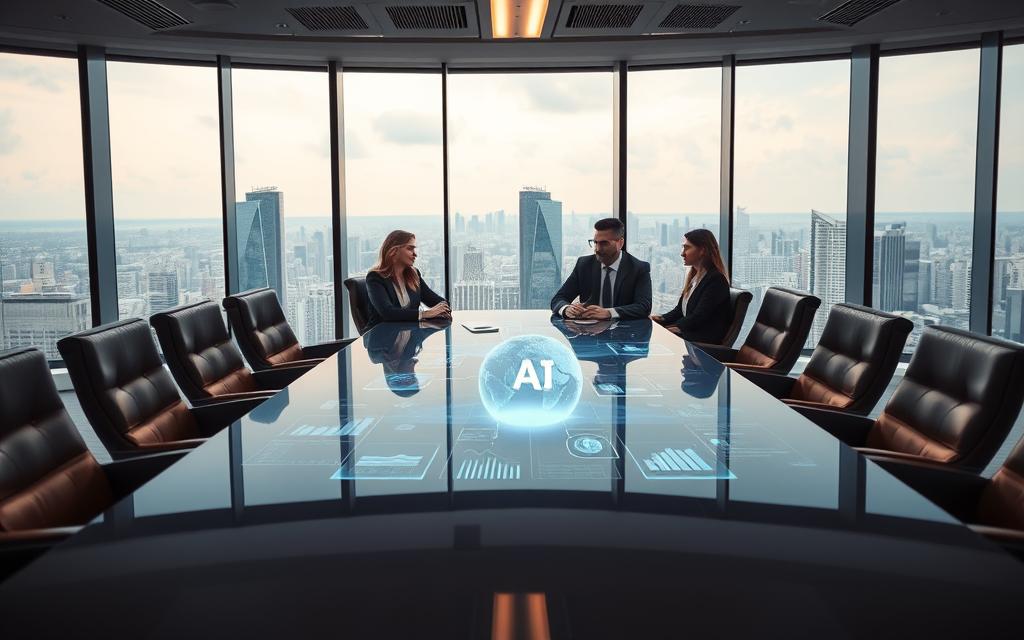Table of Contents
Modern companies face fierce competition. Staying ahead requires smart decisions backed by data. A staggering 73% of U.S. businesses now rely on advanced tools to drive growth, according to PwC.
Early adopters see clear advantages. McKinsey reports cost reductions and revenue boosts from predictive analytics. Lagging behind risks losing market share.
Retail and healthcare leaders already use these strategies to understand customer needs. The right approach turns raw numbers into actionable insights.
This shift isn’t optional. Business leaders must embrace new methods or fall behind. The following sections explore practical ways to implement these solutions.
How Artificial Intelligence Can Be Used for Gaining Business Insights
Companies now process vast amounts data daily. Traditional methods struggle to keep up. Advanced technologies unlock hidden opportunities faster than ever.
The Power of Pattern Recognition
At its core, AI excels at spotting patterns humans miss. IBM research shows these systems analyze information 10,000x faster than manual reviews. This speed reveals trends in customer behavior, market shifts, and operational gaps.
Machine learning takes this further. Unlike static reports, ML algorithms improve with each dataset. McKinsey found they identify complex relationships in 82% less time. Retailers like Amazon use this to predict demand spikes before they happen.
Predictive Analytics in Action
This technology forecasts outcomes with startling accuracy. The workflow involves three steps:
- Collecting clean, structured data
- Training models on historical patterns
- Generating real-time forecasts
Shell applied this to oil drilling. Their AI reduced equipment failures by 60% while boosting output. Similar approaches help hospitals predict patient admissions, cutting wait times by 30%.
| Technology | Impact | Industry Example |
|---|---|---|
| Machine Learning | 70% faster insights | Fraud detection in banking |
| Predictive Analytics | 28% cost reduction | Supply chain optimization |
| Neural Networks | 92% diagnostic accuracy | Medical imaging analysis |
Leading platforms like Tableau and IBM watsonx make these tools accessible. However, success depends on data quality. Inaccurate inputs lead to flawed predictions—structured datasets yield the best results.
The predictive analytics market will hit $28 billion by 2026. Early adopters gain a clear edge. Those who wait risk playing catch-up in an AI-driven economy.
6 AI Strategies to Transform Your Business Operations
Forward-thinking organizations leverage advanced strategies to stay competitive. These approaches cut costs, boost efficiency, and enhance customer experiences. Here are six proven methods with measurable results.

Automating Repetitive Tasks for Efficiency
Manual data entry drains productivity. Smart automation handles high-volume tasks like invoice processing 80% faster. Focus teams on strategic work instead.
- High-volume: Payroll, reporting, data transfers
- High-complexity: Customer segmentation, inventory reconciliation
ChatGPT-powered systems now resolve 65% of service queries without human agents. This slashes response time while maintaining quality.
Enhancing Customer Experience with Personalization
Sephora’s Virtual Artist boosted sales by 11% through tailored product recommendations. AI analyzes browsing history and purchase patterns to serve relevant suggestions.
“Personalized experiences drive 91% higher engagement versus generic offers.”
Discover more about AI-powered personalization strategies that increase conversions.
Leveraging Predictive Analytics for Decision-Making
Financial institutions improved forecasting accuracy by 42% using ML models. These tools analyze historical data to predict market shifts before they occur.
Key applications:
- Demand forecasting
- Price optimization
- Risk assessment
Optimizing Inventory and Supply Chains
Heineken reduced inventory costs by 30% through AI-driven demand prediction. Walmart’s routing system cut delivery miles by 15% annually.
Real-time tracking prevents stockouts and overstocking. Sensors monitor warehouse conditions to protect perishable goods.
Streamlining Marketing Campaigns with AI Tools
Sprout Social users saw 28% higher ROI from automated ad placements. AI continuously tests creatives, audiences, and timing for optimal performance.
Top benefits:
- Dynamic budget allocation
- Real-time performance analysis
- Hyper-targeted audience segmentation
Mitigating Risks Through AI-Powered Forecasting
Mastercard detects fraudulent transactions 45% faster with deep learning. Manufacturers reduced defects by 22% using computer vision for quality control.
Deloitte reports 60% fewer supply chain disruptions when using predictive models. These systems flag potential issues weeks in advance.
Implementation roadmap:
- Identify high-impact use cases
- Run controlled pilot tests
- Scale successful initiatives
- Continuously optimize models
Real-World Examples of AI-Driven Business Success
Leading brands now harness advanced technology to reshape industries. These pioneers demonstrate how solutions translate into profits, efficiency, and superior customer experience. Below are standout cases across key sectors.
Retail: Dynamic Pricing and Demand Prediction
Amazon’s AI adjusts prices in real time, boosting profits by 29%. The system analyzes trends, competitor pricing, and inventory levels to optimize revenue.
Starbucks leverages hyper-personalized marketing. Their algorithm recommends products based on purchase history, driving a 21% lift in customer lifetime value.
- Zara cut design-to-shelf time by 40% using AI-generated fashion trends.
- L’Oréal’s ModiFace AR try-on tool increased online conversions by 18%.
Healthcare: Diagnostic Accuracy and Patient Care
Johns Hopkins Hospital improved diagnostic precision by 37% with AI-assisted imaging. Errors dropped significantly, enhancing patient outcomes.
Cleveland Clinic’s monitoring system predicts health risks 48 hours in advance. This reduces ICU readmissions and engagement with preventive care.
“AI doesn’t replace doctors—it empowers them to make faster, more accurate decisions.”
Finance: Fraud Detection and Automated Trading
JPMorgan Chase saves $1.5 billion annually using AI for contract review. What took 360,000 hours now takes seconds.
Capital One’s chatbot handles 80% of routine inquiries, freeing staff for complex interactions. Fraud detection rates improved by 45% with machine learning.
Explore more about AI’s transformative potential in modern enterprises.
Logistics and Manufacturing
DHL’s predictive routing ensures 98% on-time delivery. Sensors track shipments and adjust routes dynamically.
Siemens reduced equipment maintenance costs by 35% using AI-powered failure predictions. Downtime dropped by 27%.
The Tangible Benefits of AI for Business Leaders
Smart investments in technology yield measurable returns for modern enterprises. For business leaders, these tools translate into lower costs, sharper insights, and unmatched scalability. Accenture reports a 45% average reduction in operational expenses among adopters.

Cost Reduction and ROI Improvement
AI slashes expenses across labor, materials, and missed opportunities. Unilever cut recruitment time by 70% using automated screening. Deloitte confirms a 3:1 ROI ratio within 18 months of implementation.
Patagonia’s supply chain AI eliminated 28% of waste. Traditional market research costs 3x more than AI-powered alternatives. Compliance violations drop by 60% with predictive monitoring.
Data-Backed Competitive Advantage
Real-time analytics empower smarter decisions. Qualtrics found AI-driven firms achieve 33% higher Net Promoter Scores. Adobe generates content at 1/10th the cost, outpacing rivals.
“Scalability is no longer a constraint—it’s a strategic lever.”
Scalability Across Business Functions
Seamless integration multiplies productivity. HR and operations synergy reduces onboarding delays by 40%. MIT SMR notes 76% of executives scale faster with AI.
These benefits compound over time. Early adopters secure lasting advantages while laggards struggle to catch up.
Future Trends: Where AI Is Taking Business Intelligence
The next wave of digital transformation is reshaping enterprise strategies. By 2027, 65% of apps will leverage AI, per IDC. Leaders must adapt to stay ahead.

Hyper-Personalization and Microtargeting
Generative AI enables real-time product customization. Nike’s AR design tool increased engagement by 34% through tailored experiences.
Dark patterns remain a risk. Ethical design ensures transparency in data usage.
AI as a Collaborative Partner
MIT research shows AI collaboration boosts productivity 40%. Tools like GitHub Copilot streamline coding, while Canva’s design suggestions enhance creativity.
Future trends predict AI “co-pilots” in 90% of enterprise software by 2030.
Ethical AI and Governance Frameworks
Gartner forecasts 80% of enterprises will have ethics committees by 2025. IBM’s AI Fairness 360 toolkit mitigates bias in models.
| Framework | Key Feature | Impact |
|---|---|---|
| PwC Governance Model | Risk scoring | 28% lower compliance costs |
| EU AI Act | Transparency logs | Reduces legal disputes |
“Ethics isn’t a constraint—it’s the foundation of sustainable innovation.”
Quantum machine learning and neuromorphic computing will accelerate decision speeds. A 5-step adoption framework ensures responsible scaling:
- Audit existing processes
- Pilot bias-free models
- Train cross-functional teams
- Monitor real-time impacts
- Iterate with stakeholder feedback
Conclusion
The race for smarter business operations is accelerating. McKinsey confirms AI-proficient firms grow 2.5x faster than peers. Yet 89% of leaders still struggle with implementation gaps.
Success requires action, not just adoption. Focus on measurable outcomes—avoid “AI theater.” Start with pilot programs in high-impact areas like customer service or inventory management.
Three critical steps:
- Audit current strategies for quick wins
- Train teams on interpreting AI-driven intelligence
- Partner with proven solution providers
By 2025, companies without AI integration will face severe disadvantages. The time for planning is over—execution separates winners from observers.
Ready to lead? Explore UC Online’s AI Business Graduate Certificate to build competitive solutions today.
FAQ
What role does AI play in data analysis?
AI processes vast amounts of data quickly, identifying patterns and trends that humans might miss. Tools like machine learning improve accuracy in predictive analytics, helping businesses make smarter decisions.
How can AI enhance customer experiences?
By analyzing customer preferences and behaviors, AI enables hyper-personalized marketing strategies. Brands like Amazon and Netflix use AI-driven recommendations to boost engagement and satisfaction.
What are the key benefits of AI for business leaders?
AI reduces costs, increases efficiency, and provides actionable insights. Companies leveraging AI gain a competitive edge through data-backed strategies and scalable solutions.
Can AI optimize supply chain management?
Yes. AI-powered tools forecast demand, streamline inventory, and minimize delays. Retail giants like Walmart use predictive analytics to maintain optimal stock levels and reduce waste.
How does AI improve marketing campaigns?
AI analyzes engagement metrics to refine ad targeting and content strategies. Platforms like Google Ads and HubSpot use machine learning to maximize ROI on marketing spend.
What future trends should businesses watch in AI?
Hyper-personalization, ethical AI governance, and collaborative AI systems are rising trends. These innovations will reshape how companies interact with customers and manage operations.









